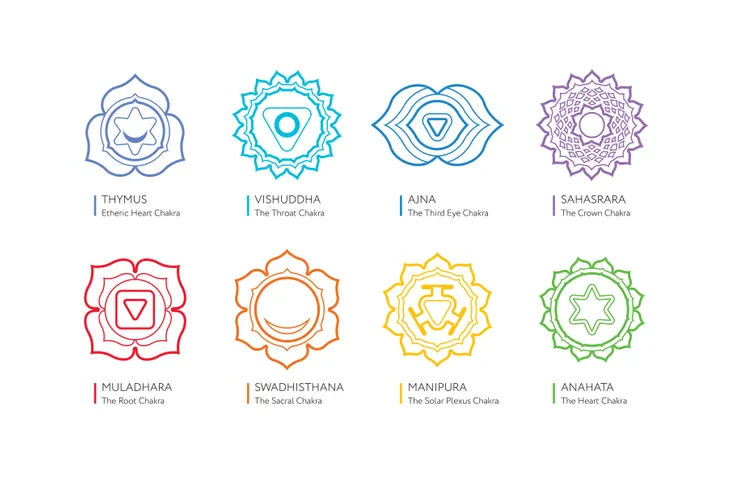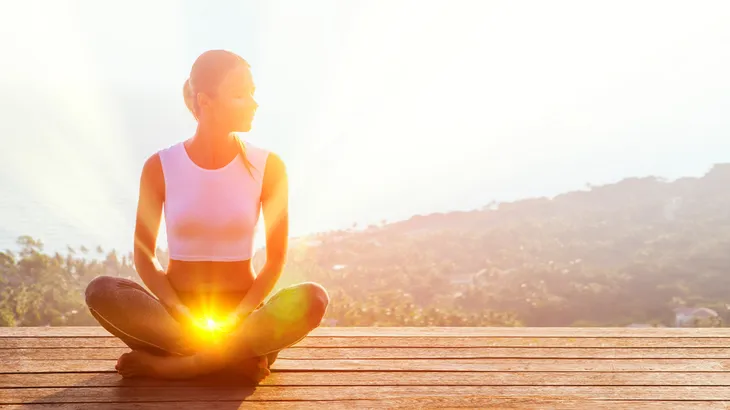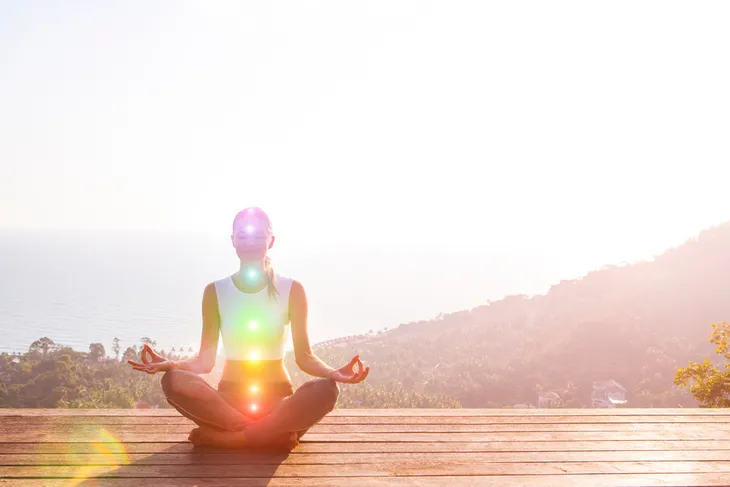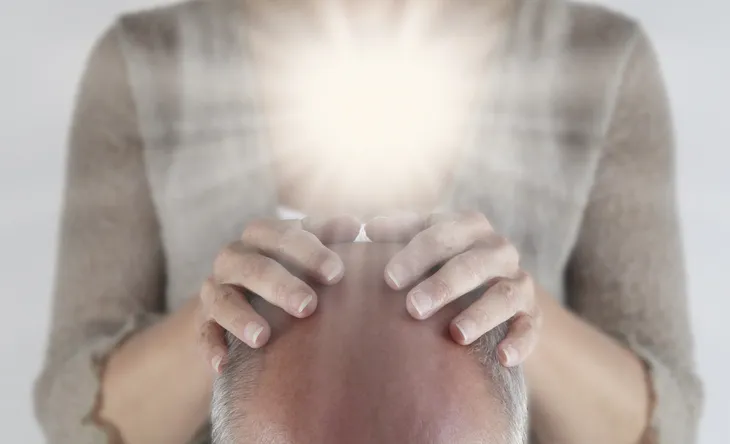If you’ve ever attended a yoga class you’ve undoubtedly heard the teacher refer to the chakras. Ancient yogis believed that the seven chakras (Sanskrit for “wheels of light”) were the energetic basis of all matter.
These energy centers are located along the spine (or Sushumna) from the base of the spine to the crown of the head, and radiate energy in color that corresponds with our physical, psychological, spiritual, and emotional wellness. The belief is that if a blockage occurs along the chakras energy line, several physical, spiritual, psychological, and emotional disorders can result.
It’s time to get in tune with your 7 yoga chakras…
1. Muladhara: The Root Chakra
Let’s begin with Muladhara, or the root chakra, which lies at the base of the spine. The root chakra is the primary grounding chakra symbolizing the grounding or stability of the body and mind, governing instinct, ambition, self-sufficiency, and responsible for physical and mental balance in health and success.
If you look at a chakra diagram, the root chakra takes the form and color of a red lotus leaf. Ancient yogis believed that if the Muladhara Chakra is blocked, problems may occur in the genitals, prostate, anus, kidneys, lower digestive tract, and adrenal glands (i.e., chronic fatigue, insomnia, sexual dysfunction, bowel dysfunction, and weight issues). Yoga poses to unblock the root chakra include locust, child, bound eagle, and wind relieving pose.
2. Svadhisthana: The Sacral Chakra
Next is Svadhisthana, the sacral chakra, which encompasses the lower abdomen or the area between the belly button and pubic bone. Svadhisthana rules our sensuality, sexuality, and reproductive system, and it’s a largely emotive chakra. Represented by an orange lotus, a blocked sacral chakra can lead to creative, emotional, and relationship blockages.
Svadhisthana is said to govern our emotional identity, personal gratification, and procreation. This explains why yogis believe a blocked sacral chakra can result in autoimmune system, sex organ, upper intestines, gallbladder, liver, kidney, spleen, or pancreas issues (i.e., lower libido, menstrual problems, sciatica, urinary tract issues, hormonal imbalances, and pelvic pain). Yoga poses to open Svadhisthana mainly focus on hip openers like hip opening poses like bound eagle and forward folds (seated and standing).
3. Manipura: The Power Chakra
Located smack dab at the naval (or solar plexus) Manipura on an emotional level governs our self esteem, self judgement, personal power, and decision-making abilities. On a physical level, the power chakra rules the stomach, small intestines, upper abdomen, middle spine, and adrenal glands.
This bright chakra, often referred to by it’s Sanskrit translation: “lustrous gem” is symbolized by a brilliant yellow lotus. When blocked, Manipura can lead to low energy, depression, lack of confidence, and low self worth. Physically, a blocked power chakra is believed to cause digestive issues (i.e., stomach ulcers; colon, pancreas, intestinal, and adrenal diseases; and metabolic issues (i.e., diabetes and eating disorders). Poses to compliment Manipura include backbends and twists such as half twist, bow, and warrior poses.
4. Anahata: The Heart Chakra
Firmly positioned at the heart center (mid chest), Anahata rules is our ooey-gooey centre, meaning it governs our ability to show compassion, sensitivity, empathy, our ability to nurture, and unconditional love and trust for others as well as for the self.
The love chakra shines as a bright green, lotus. Thought to be responsible for immune strength and endocrine system function, on an emotional front a blocked Anahata chakra can lead to commitment issues, trust issues, lack of compassion, as well as feelings of jealousy, envy, and bitterness. Physically, because this chakra governs the heart, blood, lungs, esophagus, diaphragm, breasts, and circulatory system, blockages are thought to lead to cardiovascular disease, respiratory issues (i.e., asthma and pneumonia), and lung disease. To explore Anahata try chest opening poses like upward facing dog, cobra, fish, and camel.
5. Vissudha: The Communication Chakra
This expressive chakra sits at the throat center. Vishudha is considered a point of purification through thought, speech, and creative expression. Represented by a blue lotus with a crescent at its center, Vissudha strikes balance emotionally and spiritually with free expression of thought and communication (both written and verbal).
Blocked communication chakras can lead to creative blocks, loss of faith, lack of willpower (i.e., addiction), and loss of decision making capabilities. Physically, Vissudha rules our trachea, mouth, vocal chords, teeth, gums, and thyroid and parathyroid glands. Blockages can result in mild issues (i.e., swollen glands, sore throat, canker sores, and mouth and gum issues) to more serious tooth, speech (i.e., laryngitis), and thyroid issues. Balance Vishudha with neck and shoulder openers like bridge, plow, and supported shoulder stand poses.
6. Ajna: The Third Eye Chakra
Ajna, or the third eye chakra, sits at the centre of the eyebrows and represents a point where dual energy channels, or nadis, (Ida and Pingala) unite to achieve improved intuition, intellect, emotional, and spiritual awareness. Symbolized by a dark indigo lotus, Ajna is often called upon in yoga when the teacher asks you to “join your hands in prayer at your third eye chakra”.
Ajna governs our inner psychic, meaning this chakra taps into our imagination and sensory perception. Blocks can lead to lack of discipline, concentration, and reality, which can can fear of reality and escapism. Physically, the third eye chakra rules our neurological system, and the pituitary and pineal glands so blocks can result in depression, learning problems, headaches, and eye problems (i.e., eyestrain, sight, and blindness). Seek higher awareness with reflective poses like seated yoga mudra, child’s pose, and guided visualization meditative breathing.
7. Sahasrara: The Crown Chakra
Often called the “crown chakra”, the Sanskrit meaning of Sahasrara is “thousand petaled lotus”, as it’s considered by yogis the centre of spiritual connectedness, consciousness, and wisdom. Centrally located at the top (or crown) of the head, Sahasrara deals with spiritual devotion and inspiration.
Symbolized as a violet (or white) lotus, yogis aim to balance Sahasrara to achieve deeper emotional and spiritual awareness with the divine. Emotional blocks can lead to feelings of identity loss, spiritual loss, apathy or lacking purpose, and a lack of personal values and ethics. Because Sahasrara rules the brain, central nervous system, and pituitary gland, blockages are thought to cause light and sound sensitivities and chronic mental and physical fatigue. Connect mind and body through balancing posture such as eagle and tree pose.










